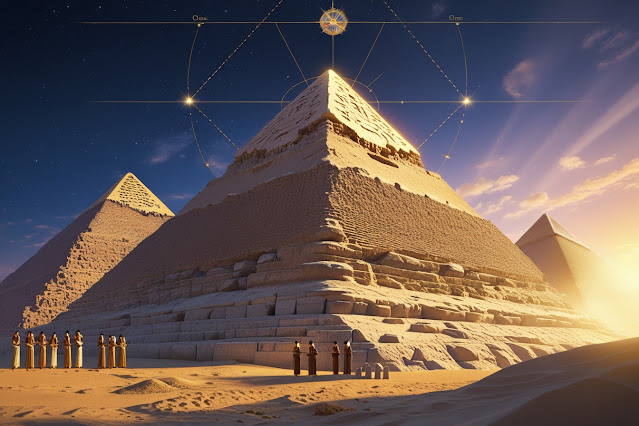Hidden Truths About the Egyptian Pyramids
1. The Pyramids Are Not Just Tombs
According to popular belief, the pyramids were constructed exclusively as pharaohs' tombs. Although many of these enormous structures fulfilled this function, new research indicates that their purposes were more intricate. Scholars have discovered shafts and chambers that don't seem to have any funerary function, which has led to conjecture about their potential uses in astronomy, ceremonies, or even energy harvesting. The pyramids' design also hints at celestial significance by matching up with certain constellations, like Orion.
The Great Pyramid itself contains the King's Chamber, the Queen's Chamber, and several mysterious shafts. Advanced scanning techniques, including muon tomography, have revealed voids and chambers still unexplored. These architectural features point to sophisticated planning and intentions beyond mere burial sites.
2. The True Builders Remain a Mystery
Some aspects of the pyramids' construction pose a challenge to modern engineering, even though historical records credit Egyptian laborers and craftsmen working under pharaohs with building them. There is still disagreement over how to move and position multi-ton blocks of granite and limestone with such accuracy. Some academics have conjectured that lost building methods or unidentified cutting-edge technologies may be involved.
Mainstream archaeology recognizes the extraordinary organization and skill needed, but it rejects alien theories. Recent discoveries of worker villages, complete with graves, tools, and bakeries, point to a highly esteemed workforce rather than slaves as previously believed. But questions remain about how such massive projects were completed in mere decades.
3. Underground Networks and Secret Tunnels
Beneath the Giza Plateau lies a complex network of tunnels and chambers, many of which are still uncharted. These subterranean structures predate some of the pyramids and could reveal new information about pre-dynastic Egypt. Some believe these tunnels were used for ceremonial purposes, storage, or even as escape routes.
The Osiris Shaft, a multi-level subterranean chamber beneath the causeway of Khafre's pyramid, is one such enigma. Discovered in the 20th century, it has revealed wooden coffins, artifacts, and deep water reservoirs. Its exact purpose, however, remains uncertain.
4. The Alignment and Mathematical Precision
The Great Pyramid is remarkably accurate, being within 1/15th of a degree of true north. Considering the tools available when it was built more than 4,500 years ago, this precision is astounding. While some academics contend that this alignment was purposeful for astronomical or religious purposes, others view it as proof of highly developed knowledge.
Furthermore, the pyramid's dimensions encode mathematical constants such as pi and the golden ratio. The ratio of its perimeter to its height, for instance, approximates 2π, leading to speculation that ancient Egyptians possessed knowledge far ahead of their time. Whether this was intentional or coincidental is still debated, but the mathematical elegance of the structure is undeniable.
5. The Mysterious Missing Capstone
It is thought that the capstone of the Great Pyramid, which is now missing, was once made of electrum or gold. The pyramidion, this capstone, might have represented a bridge connecting the divine and the material world. Theories about theft, erosion, or deliberate removal during antiquity have been bolstered by its absence.
Some esoteric theories propose that the capstone held metaphysical significance, acting as an energy focal point or spiritual beacon. While there's no definitive proof, ancient texts and symbolic depictions lend some weight to this idea.
6. Pyramid Energetics and Unproven Theories
Over the years, theories have emerged suggesting the pyramids had energetic properties. Some claim the structures generate subtle energy fields, while others link them to geopathic zones or ley lines. Though largely dismissed by mainstream science, these ideas persist due to anecdotal evidence and fringe experiments.
In the 1970s, Czech engineer Karel Drbal tested the idea that pyramids could preserve organic matter. He claimed that pyramid-shaped structures could keep food fresh and even sharpen razors. While not widely accepted, such experiments added to the mystique surrounding the pyramids.
7. Hieroglyphs Without Explanation
While hieroglyphs cover many ancient Egyptian structures, the Great Pyramid is strangely devoid of decoration. The inner chambers are almost entirely bare, leading to speculation that the pyramid’s true purpose might have been intentionally concealed. Some researchers believe symbolic meaning is embedded in the geometry and architecture rather than in language.
Additionally, some carvings found near the pyramids depict advanced-looking devices, which some interpret as evidence of misunderstood ancient technology. While mainstream archaeologists view these as symbolic or misinterpreted, their unusual nature fuels ongoing debate.
Conclusion: A Monument Still Whispering Secrets
The layers of mystery that the Egyptian pyramids hold, in addition to their grandeur, continue to enthrall us. We are gradually removing the layers of time thanks to new technologies that allow for deeper investigation and analysis. However, every new finding frequently raises more questions than it does answers. The pyramids are timeless representations of human ambition, inventiveness, and possibly undiscovered knowledge, whether they are used as tombs, cosmic markers, or something deeper.








No comments:
Post a Comment